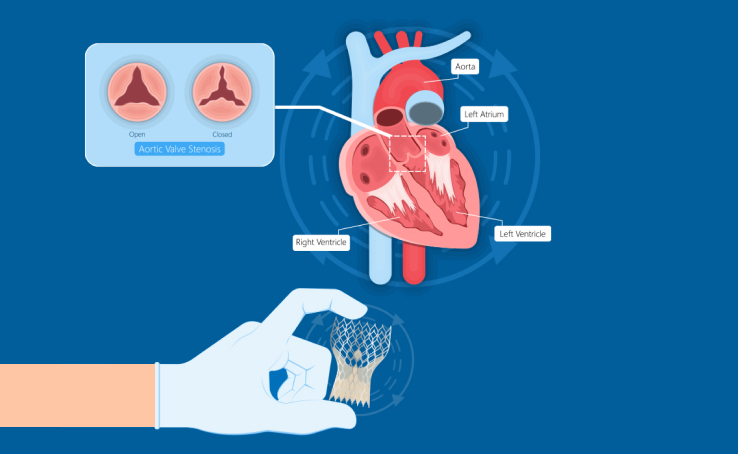Share your medical reports and get an exclusive offer tailored to your needs, requirements and preferences
Avg Price: $ 18000-$ 37000


Treatment Time
Recovery Time
Hospitalization Days
Success Rate
Aortic Stenosis (AS), a prevalent type of heart valve disorder, stands as the primary cause necessitating valve replacement. The occurrence of aortic stenosis ranges from approximately 0.3% to 0.5% in the broader population, but it substantially elevates among older individuals, with an estimated frequency of 2% to 7% in those aged above 65. Severe aortic stenosis that presents with symptoms is linked to significant mortality rates, reaching as high as 50% within a year. This situation is anticipated to intensify due to the aging demographics of Western nations, leading to a greater load of aortic stenosis.
This emphasizes the necessity for treatment options like the Transcatheter Aortic Valve Implantation (TAVI) procedure in the current situation. This Technique has established itself as the fundamental treatment for individuals dealing with severe aortic stenosis. TAVI has transformed the treatment approaches for aortic stenosis (not caused by rheumatic factors). It also looks promising for treating aortic stenosis caused by rheumatic factors in the future.
The effectiveness of such therapies relies on the skill of the healthcare provider. In India, medical professionals demonstrate impressive qualifications and specialized expertise in the realm of cardiovascular surgeries and cardiac well-being. At present, Transcatheter Aortic Valve Implantation (TAVI) is being conducted in approximately 30 medical facilities across India, with approximately seven of these centers managing the larger portion of TAVI procedures.
Despite being a developing country, India is rapidly evolving into a notable center for cardiac healthcare. Specifically, medical institutions in India have been making impressive advancements in the realm of heart care, including specialized procedures like Transcatheter Aortic Valve Implantation (TAVI). As a result, the effort to find the best doctor for TAVI and the best hospital for TAVI is becoming progressively easier and more financially feasible with the advancing time in India.
Transcatheter Aortic Valve Implantation (TAVI) is a less invasive cardiac intervention used to substitute a narrowed aortic valve that is unable to open fully, a condition known as aortic valve stenosis. The aortic valve is situated between the left lower chamber of the heart (left ventricle) and the body's main artery (aorta). When the valve fails to open properly, it results in decreased blood flow from the heart to the body.
TAVI serves to reestablish proper blood circulation and alleviate the symptoms associated with aortic valve stenosis, which may include chest discomfort, breathlessness, loss of consciousness, and fatigue.
Transcatheter Aortic Valve Implantation might be a suitable choice for individuals who are suspected to face potential complications from conventional surgical aortic valve replacement (open-heart surgery). The decision to address aortic stenosis through TAVI is reached after consulting a team of cardiac specialists and surgeons, who collaborate to identify the optimal treatment avenue for such situations. Those who undergo TAVI typically experience a shorter hospital stay compared to those who undergo surgical aortic valve replacement.
Your doctor might suggest this procedure if you have:
Take Charge of Your Health
Book a Free Consultation

Following are the several types of TAVI techniques, each with its own approach and advantages:
The pre-evaluation is pivotal for ascertaining the appropriateness of TAVI as a viable approach and for mitigating possible risks in the perioperative and postoperative periods. Below is an overview of the pre-evaluation process:
Your Health is Our Priority
Book a Free Consultation
During your TAVI procedure, you'll be taken to the procedure room either on a trolley or in a wheelchair and asked to lie down on a narrow table designed for the procedure. Throughout the process, you will remain awake, and your doctor will administer medication to help you to relax. The targeted area is numbed, and you'll receive either local anesthesia with sedation or a general anesthesia. This will be discussed with you prior to the procedure. A catheter with a balloon is inserted into an artery, either in your groin or beneath your collarbone. Skillfully guided into your heart, the balloon catheter is positioned within the opening of your aortic valve. Your doctor carefully inflates the balloon to expand the valve. A new aortic valve, held within a metal mesh tube, is implanted. The new valve either self-expands or is expanded using the balloon, depending on the valve type. The new valve is positioned to gently displace your damaged aortic valve. The balloon is deflated, and your doctor removes the balloon catheter.
Clinical trials have demonstrated the safety and efficacy of Transcatheter Aortic Valve Implantation (TAVI). Although it offers a less invasive option compared to conventional open-heart surgery, there remains a possibility of encountering complications. It's crucial to acknowledge that complications are not universally encountered, and a considerable number of TAVI procedures yield positive outcomes without notable problems. Nevertheless, here are several potential complications linked to TAVI:

After your Transcatheter Aortic Valve Implantation (TAVI), there's a possibility that you'll spend the night under monitoring in the intensive care unit (ICU). The duration of your hospital stay following this procedure hinges on various factors. Some TAVR recipients get discharged and head home as early as the next day.
Before you're discharged, your medical team will provide instructions on caring for any incisions and how to be vigilant for indications of infection. Red flags for infection encompass heightened body temperature, increased pain, as well as redness, swelling, discharge, or oozing at the catheter insertion site.
Following TAVI, you might be prescribed several medications, which include:
After TAVR, it's imperative to attend regular medical checkups and undergo imaging tests to ensure the proper functionality of the newly implanted valve. In the event of any fresh or escalating symptoms, such as:
Avail the Expert Health Advice
Book a Free Consultation
Certain patients experience immediate relief from their symptoms shortly after undergoing the TAVI procedure, although it's common for a bit more time to be required to fully return to their regular state.
Research indicates that individuals who undergo TAVI frequently experience symptom reduction, enhanced self-care capabilities, improved heart function, and an overall better quality of life within the span of 30 days.
In many cases, patients can resume work within two weeks following the procedure. However, there are certain limitations to be observed after Transcatheter Aortic Valve Implantation procedure, such as refraining from heavy lifting exceeding 5 to 10 lbs. for the initial week. For a week, driving is discouraged, and it's advised not to submerge the incision site(s) in water, including bathtubs, swimming pools, or hot tubs.
A follow-up appointment, typically scheduled for a week after the procedure, should be arranged. Within the subsequent 30 days, an echocardiogram is recommended, followed by annual echocardiograms conducted in collaboration with your cardiologist.
Following a TAVI procedure, the majority of individuals typically experience an improvement in their symptoms and an enhanced ability to engage in daily activities. However, a minority of patients might encounter complications subsequent to the TAVI procedure. The likelihood of complications varies according to the patient’s general health status and the specific condition of the heart.
As a result of the hemodynamic and functional impacts of TAVI, there has been a notable enhancement in the immediate and medium-term survival rates among individuals with aortic stenosis (AS). According to research, the survival rates of 92.9%, 78.6%, and 73.7% were observed at 30 days, 1 year, and 2 years post-TAVI, respectively which indicates a remarkable improvement. Various studies have indicated that the transfemoral approach yields superior survival outcomes when contrasted with alternative approaches.
India's healthcare system capitalizes on decreased labor and infrastructure costs, enabling healthcare establishments to furnish services at more affordable prices. Moreover, the presence of proficient medical experts combined with a competitive market cultivates economically efficient approaches. Additionally, India's thriving pharmaceutical sector frequently manufactures generic drugs, which contributes to a decrease in the overall cost of treatment. This is the reason for the relatively reduced cost of Transcatheter Aortic Valve Implantation in India in comparison to other nations like USA where this cost is USD 50700 which is comparatively too high.
| Location | Minimum Cost ($) | Average Cost ($) | Maximum Cost ($) |
| Delhi | 22000 | 30000 | 35000 |
| Mumbai | 20500 | 25500 | 36500 |
| Chennai | 18000 | 25000 | 37000 |
| Hyderabad | 22000 | 30000 | 35000 |
Nonetheless, the cost of Transcatheter Aortic Valve Implantation in India might fluctuate contingent on the subsequent key aspects:
The expenses associated with the preliminary assessments and examinations conducted prior to the Transcatheter Aortic Valve Implantation might cover various diagnostic procedures. These additional charges encompass tests such as X-rays, CT scans (computed tomography), MRI scans (magnetic resonance imaging), pulmonary function tests (PFTs), carotid doppler/ultrasound studies (carotids), a, surface echocardiograms (Echo), trans-esophageal echocardiograms (TEE), heart catheterization (Cath), and other diagnostic evaluations. The total expenses for these tests can vary between INR 1,00,000 and INR 1,50,000.
MedFlick, your trusted healthcare companion, is dedicated to ensuring that your medical journey goes as smoothly and successfully as possible.
Fostering expertise backed by commitment, resilience and years of experience, we connect you to a wide network of India's best doctors
Explore the most advanced, reputable and trusted hospitals in India, offering the highest levels of clinical and surgical excellence

The worlds most trusted personalized health community with more than 1,00, 000 members that share their journey, experiences and health insights. Join your community and get access to make informed health decisions.
Explore


